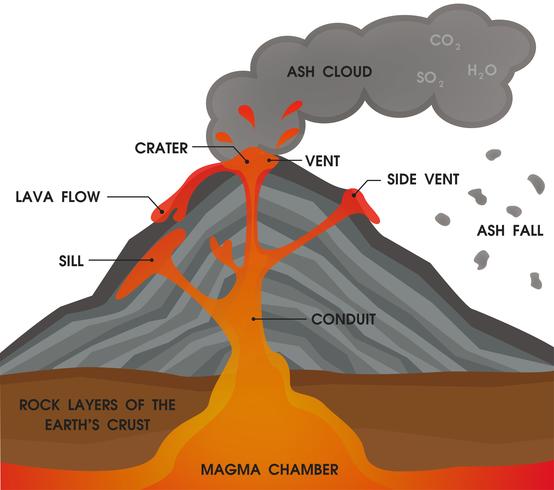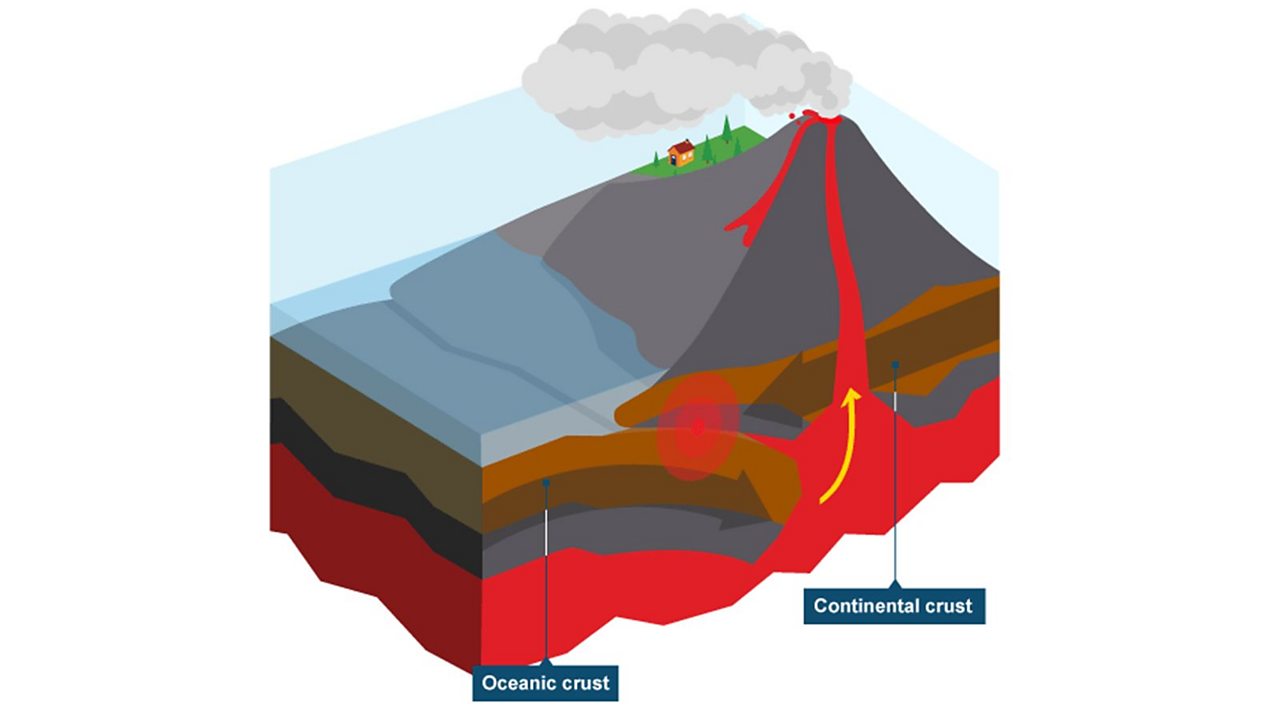
Pelée on the Caribbean island of Martinique. Pyroclastic flows killed approximately 30,000 during the 1902 eruption of Mt. Hot, fast moving pyroclastic flows and lahars are the two main causes of casualties in volcanic eruptions. This type of eruption can also lead to rapid melting of ice and snow on a volcano, and that typically triggers large mudflows known as lahars (Figure 7.3.5a). Under these circumstances pressure builds up until some part of the volcano gives way, and then an explosive eruption results, producing pyroclastic debris, as shown on Figure 7.3.5a. As already noted, felsic magma doesn’t flow easily and doesn’t allow gases to escape easily. Helens ranges in composition from rhyolite (Figure 7.3.5a) to basalt (Figure 7.3.5b), and that implies that the types of past eruptions have varied widely in their character. Figure 7.3.4 A Cross-Section Through the Upper Part of the Crust at Mt. Between 19 the slow eruption of more lava led to construction of a dome inside the crater. The large 1980 eruption reduced the height of the volcano by 400 m, and a sector collapse removed a large part of the northern flank. Helens in South-Western Washington State, 2003. Helens imply that the magma chamber is zoned, from more felsic at the top to more mafic at the bottom. Systematic variations in the composition of volcanism over the past several thousand years at Mt. Helens, there is evidence of a magma chamber that is approximately 1 kilometre in width and extends from about 6 to 14 km depth below surface (Figure 7.3.4). At many such volcanoes magma is stored in a magma chamber in the upper part of the crust. Helens in Washington State (Figure 7.3.3), are almost all associated with subduction at convergent plate boundaries-either ocean-continent or ocean-ocean boundaries (Figure 7.1.2b). Composite VolcanoesĬomposite volcanoes, like Mt Merapi in Java (Figure 7.0.1) or Mt. Figure 7.3.2 Eve Cone, Which Rises About 170 m Above the Surrounding Plateau, Formed Approximately 700 Years Ago. Because cinder cones are made up almost exclusively of loose fragments, they have very little strength and can be easily, and relatively quickly, eroded away. Most cinder cones are monogenetic, meaning that they were created during a single eruptive phase that might have lasted weeks or months. Most are comprised of fragments of vesicular mafic volcanic rock that were blasted out during a high-gas-pressure early phase of an eruption that may have subsequently become effusive (lava flows). Helens), and a Large Cinder Cone Cinder ConesĬinder cones, like Eve Cone in northern BC (Figure 7.3.2), are typically only a few hundred metres in diameter and few are more than 200 m high. Figure 7.3.1 Profiles of a Shield Volcano (Mauna Loa and Kilauea), a Composite Volcano (Mt. On this drawing even a large cinder cone is just a dot. It is about 6 km across at the base, and its height is 2550 m above sea level. Helens, a composite volcano, rises above the surrounding hills of the Cascade Range.

#Shield volcanoes diagrams full
Mauna Loa rises from the surrounding flat sea floor, and its full diameter is in the order of 200 km, with a diameter of about 100 km above sea level. The sizes and shapes of typical shield, composite and cinder-cone volcanoes are compared on Figure 7.3.1, although, to be fair, Mauna Loa is the largest shield volcano on Earth, all others are smaller. The youngest one is over 10 ka, and all others are over 30 Ma. Most appear to have had explosive eruptions forming cinder cones. The remnants are typically 10s to 100s of m across Most of the oceanic crust formed at spreading ridgesĪt normal eruption rates pillows form. Generally associated with spreading ridges but also mantle plumes

Individual flows can be 10s of metres thick Magma is almost always mafic, and eruptions are typically effusive, although cinder cones are common on the flanks of shield volcanoesĮnormous (up to millions of km2) and 100s of m thick

Large (up to several 1000 m high and 200 km across), not steep (typically 2 to 10°) Most are at mantle plumes, some on spreading ridges

Magma composition varies from felsic to mafic, and from explosive to effusive Medium size (1000s of m) and moderate steepness (10 to 30°) Most are mafic and form from the gas-rich early stages of a shield- or rift-associated eruption Small (10s to 100s of m) and steep (>30°) Some form on the flanks of other volcanoes Table 7.3.1 Summary of Common Types of Volcanism Type There are numerous types of volcanism some of the more common ones are summarized in Table 7.3.1.


 0 kommentar(er)
0 kommentar(er)
